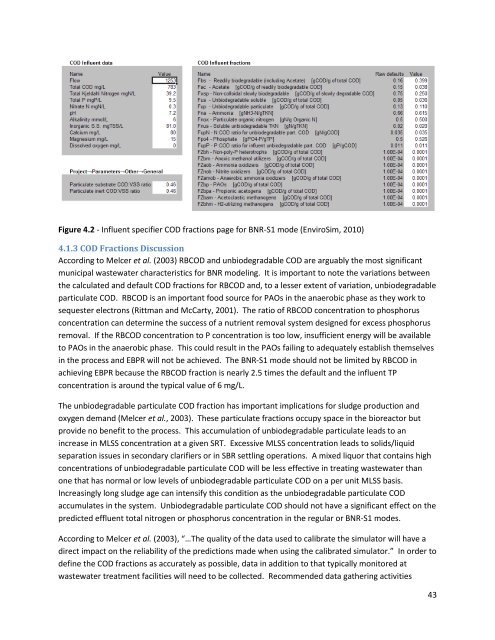E-Andrew Sindt Creative Component S11.pdf
E-Andrew Sindt Creative Component S11.pdf
E-Andrew Sindt Creative Component S11.pdf
Create successful ePaper yourself
Turn your PDF publications into a flip-book with our unique Google optimized e-Paper software.
Figure 4.2 - Influent specifier COD fractions page for BNR-S1 mode (EnviroSim, 2010)4.1.3 COD Fractions DiscussionAccording to Melcer et al. (2003) RBCOD and unbiodegradable COD are arguably the most significantmunicipal wastewater characteristics for BNR modeling. It is important to note the variations betweenthe calculated and default COD fractions for RBCOD and, to a lesser extent of variation, unbiodegradableparticulate COD. RBCOD is an important food source for PAOs in the anaerobic phase as they work tosequester electrons (Rittman and McCarty, 2001). The ratio of RBCOD concentration to phosphorusconcentration can determine the success of a nutrient removal system designed for excess phosphorusremoval. If the RBCOD concentration to P concentration is too low, insufficient energy will be availableto PAOs in the anaerobic phase. This could result in the PAOs failing to adequately establish themselvesin the process and EBPR will not be achieved. The BNR-S1 mode should not be limited by RBCOD inachieving EBPR because the RBCOD fraction is nearly 2.5 times the default and the influent TPconcentration is around the typical value of 6 mg/L.The unbiodegradable particulate COD fraction has important implications for sludge production andoxygen demand (Melcer et al., 2003). These particulate fractions occupy space in the bioreactor butprovide no benefit to the process. This accumulation of unbiodegradable particulate leads to anincrease in MLSS concentration at a given SRT. Excessive MLSS concentration leads to solids/liquidseparation issues in secondary clarifiers or in SBR settling operations. A mixed liquor that contains highconcentrations of unbiodegradable particulate COD will be less effective in treating wastewater thanone that has normal or low levels of unbiodegradable particulate COD on a per unit MLSS basis.Increasingly long sludge age can intensify this condition as the unbiodegradable particulate CODaccumulates in the system. Unbiodegradable particulate COD should not have a significant effect on thepredicted effluent total nitrogen or phosphorus concentration in the regular or BNR-S1 modes.According to Melcer et al. (2003), “…The quality of the data used to calibrate the simulator will have adirect impact on the reliability of the predictions made when using the calibrated simulator.” In order todefine the COD fractions as accurately as possible, data in addition to that typically monitored atwastewater treatment facilities will need to be collected. Recommended data gathering activities43
















